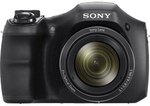same deal as this http://www.ozbargain.com.au/node/89430 in DEC 2012. Now back in stocks again at DICK SMITH. Online Only apparently.
http://dicksmith.com.au/product/XG1519/sony-h100-digital-cam…
Ps. HTC Velocity 4G is also back online for delivery again.
http://dicksmith.com.au/product/EM5165/htc-velocity-4g-unloc…


Good idea - get rid of the DSE shops altogether - DSE head office policy seems a little confused at the mo - homer where are you - you're needed there urgently?